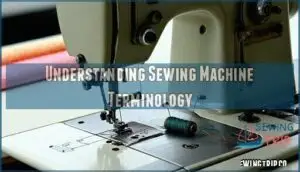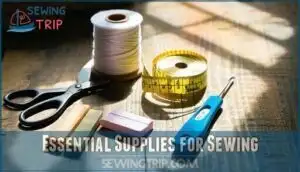This site is supported by our readers. We may earn a commission, at no cost to you, if you purchase through links.

Set up your workspace in a well-lit area with enough room to spread fabric comfortably. Begin with simple projects like pillowcases or tote bags to build confidence before tackling complex garments.
Practice basic stitches on fabric scraps first. Watch online tutorials and follow step-by-step patterns designed for beginners.
Don’t rush the process – sewing is like learning to ride a bike, requiring patience and practice. The key is consistency and working within your skill level.
Once you master these fundamentals, you’ll discover techniques that transform everyday materials into professional-looking creations.
Table Of Contents
- Key Takeaways
- Choosing a Sewing Machine
- Getting Started With Your Sewing Machine
- Understanding Sewing Machine Terminology
- Essential Supplies for Sewing
- Learning Basic Hand Sewing Stitches
- Starting With Simple Sewing Projects
- Progressing to Advanced Techniques
- Tips for Successful Sewing at Home
- Frequently Asked Questions (FAQs)
- Conclusion
Key Takeaways
- Start with the right equipment – You’ll need a reliable sewing machine, basic thread, fabric scissors, and measuring tape to build your foundation for successful home sewing.
- Practice basic skills before jumping into projects – Master fundamental hand stitches and machine operations on fabric scraps first; then progress to simple projects like pillowcases or tote bags.
- Create an organized workspace – Set up a well-lit area with enough room to spread fabric comfortably, and keep your supplies organized within arm’s reach for efficient sewing sessions.
- Don’t rush the learning process – Take your time with each project, read patterns completely before cutting, and embrace mistakes as learning opportunities that will improve your skills over time.
Choosing a Sewing Machine
When starting your sewing journey, choosing the right machine sets the foundation for years of creative projects. Your budget determines your options, with machines ranging from $50 to $15,000.
Entry-level models handle basic tasks like hemming and simple repairs perfectly. Focus on Machine Features that matter most: reliable straight and zigzag stitches, easy threading, and smooth bobbin loading.
Focus on what truly matters: reliable stitching, effortless threading, and smooth operation that won’t fight you every step of the way.
Mechanical machines offer better Brand Reliability than computerized versions for beginners. The Janome HD-3000 and Husqvarna Viking Onyx 25 are solid Beginner Models that won’t overwhelm you with unnecessary complexity.
Consider Used Machines from reputable dealers or sewing shops. Test any machine before buying to guarantee smooth operation. Metal components last longer than plastic parts, so prioritize quality construction over flashy features.
Investing in a machine with metal internal components guarantees greater durability. Budget Considerations should balance current needs with future growth. A reliable basic machine beats an expensive model you can’t operate confidently.
Read sewing machine reviews and follow buying guide recommendations to make an informed choice.
Getting Started With Your Sewing Machine
Confidence builds when you master your sewing machine’s basic operations.
Start with proper machine setup by reading your manual thoroughly and identifying key components. The presser foot should be securely attached before sewing.
- Threading Basics: Follow your manual’s threading path carefully and check tension settings
- Bobbin Winding: Wind smoothly and insert the bobbin case correctly underneath
- Stitch Selection: Begin with straight stitches before exploring other options
- Fabric Feeding: Let the machine feed fabric naturally while you guide gently
- Practice Sessions: Use fabric scraps to master stitch length and control
These sewing machine tips create your foundation for successful projects ahead.
Understanding Sewing Machine Terminology
Learning sewing terminology helps you navigate your machine with confidence. Your sewing machine has key parts that control how fabric moves and stitches form.
Feed dogs grip fabric and move it forward while you sew. The bobbin holds bottom thread and needs proper winding for smooth stitches. Understanding these basics prevents frustration later.
One must understand what is sewing terminology to communicate techniques precisely.
| Term | Definition |
|---|---|
| Stitch Length | Controls spacing between needle punctures |
| Tension Settings | Adjusts how tight thread pulls through fabric |
| Feed Dogs | Metal teeth that move fabric under the needle |
| Bobbin Winding | Process of loading thread onto the bobbin spool |
sewing-terminology-table
Essential Supplies for Sewing
Now that you understand your sewing machine, let’s stock your sewing toolkit with the right supplies. Think of these sewing materials as your creative foundation – without them, even the best sewing machine sits idle.
Here’s what you’ll need to get started:
- Fabric scissors – Sharp cutting tools reserved only for fabric
- Universal thread – All-purpose polyester works for most fabric types
- Measuring tools – A flexible tape measure for accurate sizing
- Marking tools – Fabric pencils or chalk for pattern guidelines
- Seam ripper – Your safety net when mistakes happen
To prevent fraying, consider using professional pinking shears.
Learning Basic Hand Sewing Stitches
Hand sewing techniques form the backbone of all sewing basics.
Master these fundamental hand stitching skills before touching a machine. Start with proper needle selection – choose size 8-10 for cotton fabrics. Perfect your thread knotting by pulling halfway through to create a secure loop.
Focus on consistent stitch spacing for professional results. Practice fabric handling by keeping gentle pressure to avoid puckering.
The running stitch creates that classic dashed-line appearance, while backstitch provides strength for seams. Always finish with proper seam securing techniques to prevent unraveling.
Learning the basting stitch usage is helpful for fabric alignment.
Starting With Simple Sewing Projects
Now that you’ve got your basic stitches down, it’s time to put thread to fabric with some Easy First Projects. Start small with potholders or simple coasters – these Quick Sewing Wins build confidence without overwhelming you.
Beginner Friendly Fabrics like cotton work best since they don’t slip around or fray easily. Try making a basic tote bag or throw pillow cover next. These sewing projects for beginners teach you straight seams and corners.
Project Customization Tips include choosing patterns you love and colors that match your home. Many beginners find success in creating reusable bags and pouches as a practical early project.
For Avoiding Common Mistakes, measure twice and cut once. Keep your stitches even and don’t rush. Remember, beginner sewing should feel rewarding, not stressful. Each finished project proves you’re mastering sewing basics one stitch at a time.
Progressing to Advanced Techniques
After months of practice, you’re ready to tackle the big leagues of sewing.
Advanced sewing opens doors to intricate garment construction, where you’ll master pattern alteration and develop sophisticated tailoring skills.
Your sewing machine becomes a precision tool for fabric manipulation techniques that transform ordinary materials into professional-quality pieces.
Start with intermediate quilting techniques before attempting complex geometric patterns.
Focus on garment construction fundamentals like setting sleeves, installing zippers, and creating professional seams.
These advanced sewing techniques require patience and practice, but they’ll elevate your work dramatically.
Pattern alteration is your gateway to custom-fit clothing.
Learn to adjust bust lines, lengthen sleeves, and modify waistlines.
Master fabric manipulation through pleating, gathering, and draping techniques.
Each skill builds upon your foundation, creating a solid base for tailoring skills.
Don’t rush the process.
Complex projects demand time and attention to detail.
Your sewing skills will flourish when you embrace the learning curve and celebrate small victories along the way.
You might also consider learning advanced embroidery techniques to further expand your creative possibilities.
Tips for Successful Sewing at Home
Creating your perfect sewing sanctuary starts with smart choices that’ll set you up for success.
Success in sewing begins with the space you create – make it yours, make it work.
Your workspace setup makes all the difference – you’ll need good lighting, a comfortable chair, and enough room to spread out your fabric without wrestling with cramped quarters.
Here are five game-changing sewing tips that’ll transform your home projects:
- Organize your supplies – Keep threads, pins, and tools within arm’s reach using clear containers or a rolling cart
- Master fabric selection – Start with cotton fabrics since they’re forgiving and easy to handle for beginners
- Practice regularly – Even 15 minutes daily builds muscle memory faster than weekend marathons
- Plan each project – Read through patterns completely before cutting your first piece
- Embrace mistakes – Every crooked seam teaches you something new about your sewing machine
Remember, patience is essential isn’t just a motto – it’s your secret weapon.
A key factor is matching thread to fabric to guarantee durability and prevent puckering.
Easy sewing comes from taking your time and following sewing tutorials step by step.
You’re building skills that’ll last a lifetime.
Frequently Asked Questions (FAQs)
How do I start sewing at home?
Nearly 40% of sewists taught themselves through online resources.
You’ll need a basic sewing machine, cotton fabric, sharp scissors, and thread.
Start with simple projects like pillowcases or tote bags to build confidence and skills.
Can I teach myself sewing?
You can teach yourself sewing through online tutorials, free courses, and practice. Start with basic stitches and simple projects. YouTube videos and step-by-step guides make learning accessible without formal instruction.
What is the easiest thing to sew as a beginner?
Sarah grabbed her first sewing machine and wondered what to tackle first.
Start with a simple tote bag or pillowcase – they’re forgiving, use basic straight stitches, and you’ll actually use them when you’re done.
How to start sewing by hand?
Start with basic supplies: needle, thread, fabric, and scissors.
Thread your needle, tie a knot, and practice the running stitch on scrap fabric.
Keep stitches even and don’t pull too tight.
How do I choose fabric for my sewing projects?
Like choosing the perfect dance partner, fabric selection sets your project’s rhythm.
Cotton works best for beginners—it’s forgiving and easy to handle.
Consider your project’s purpose, then match fabric weight and stretch to your skill level.
This will help you find the right fabric for your needs.
What are some tips for layout, cutting, and marking fabric before sewing?
Lay fabric on a flat surface, smooth out wrinkles, and pin your pattern pieces following the grainline arrows.
Mark notches with chalk or washable markers, then cut with sharp fabric scissors in long, confident strokes.
How do I fix common sewing mistakes?
Mistakes happen to everyone who sews.
Remove crooked stitches with a seam ripper, working slowly to avoid fabric tears.
For puckered seams, adjust thread tension.
Misaligned pieces need careful repositioning before re-stitching.
What fabric types work best for beginners?
Cotton fabric makes up 75% of beginner sewing projects because it’s forgiving and easy to handle.
You’ll want to choose quilting cotton, muslin, or lightweight denim since they don’t stretch or fray easily while you’re learning.
How do I properly maintain my sewing machine?
Clean your machine after every project by removing lint with a brush.
Oil moving parts monthly following your manual’s guide.
Replace needles regularly and use quality thread to prevent jams and keep stitches smooth.
Whats the difference between seam allowances?
Seam allowances determine how much fabric you’ll leave between your stitching line and fabric edge. Standard allowances are 5/8 inch for garments and 1/4 inch for quilts, affecting fit and durability.
Conclusion
Picture yourself confidently threading your machine and creating beautiful handmade items that friends admire.
Learning how to sew at home transforms from an intimidating challenge into an enjoyable skill when you follow the right steps.
Start with basic supplies, practice fundamental stitches, and choose beginner-friendly projects. Your patience and dedication will reward you with professional-looking results.
Remember that every expert seamstress started exactly where you’re now. Take your time, stay consistent, and enjoy this creative journey.
- https://www.instructables.com/How-to-Sew./
- https://www.reddit.com/r/sewing/comments/qq6ltv/how_to_get_into_sewing_with_no_experience/
- https://www.quora.com/Whats-the-easiest-way-for-an-adult-beginner-to-learn-how-to-sew-by-hand-and-or-using-a-basic-home-sewing-machine
- https://www.brother-usa.com/home/how-to-sew?srsltid=AfmBOorvYcnMDOyiobY8YFBRQ2f_6-ItZ3Kr6Tqwc_fbMwlJenFlVaUV
- https://abeautifulmess.com/2019/11/reusable-makeup-wipe-diy.html











